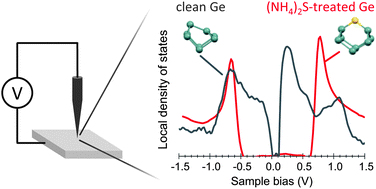Impact of ammonium sulfide solution on electronic properties and ambient stability of germanium surfaces: towards Ge-based microelectronic devices
Abstract
The monolayer

* Corresponding authors
a
Instituut voor Kern- en Stralingsfysica, KU Leuven, Celestijnenlaan 200D, BE-3001 Leuven, Belgium
E-mail:
fleischm@imec.be
b Laboratorium voor Vaste-Stoffysica en Magnetisme, KU Leuven, Celestijnenlaan 200D, BE-3001 Leuven, Belgium
c Physikalisch-Technische Bundesanstalt, Abbestrasse 2-12, D-10587 Berlin, Germany
d imec, Kapeldreef 75, BE-3001 Leuven, Belgium
e Institute for Materials Research, Hasselt University, Wetenschapspark 1, BE-3590 Diepenbeek, Belgium
The monolayer

 Please wait while we load your content...
Something went wrong. Try again?
Please wait while we load your content...
Something went wrong. Try again?
C. Fleischmann, K. Schouteden, M. Müller, P. Hönicke, B. Beckhoff, S. Sioncke, H. Boyen, M. Meuris, C. Van Haesendonck, K. Temst and A. Vantomme, J. Mater. Chem. C, 2013, 1, 4105 DOI: 10.1039/C3TC30424H
To request permission to reproduce material from this article, please go to the Copyright Clearance Center request page.
If you are an author contributing to an RSC publication, you do not need to request permission provided correct acknowledgement is given.
If you are the author of this article, you do not need to request permission to reproduce figures and diagrams provided correct acknowledgement is given. If you want to reproduce the whole article in a third-party publication (excluding your thesis/dissertation for which permission is not required) please go to the Copyright Clearance Center request page.
Read more about how to correctly acknowledge RSC content.
 Fetching data from CrossRef.
Fetching data from CrossRef.
This may take some time to load.
Loading related content
